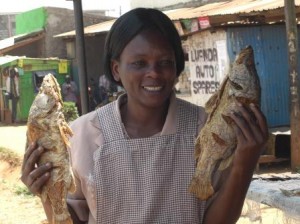AquaFish Strengthens Fish Value Chains for Men and Women Fish Farmers
Declines in the wild fish catches in Kenya’s Lake Victoria have spurred the expansion of fish farming in the region. The Feed the Future Innovation Lab for Collaborative Research on Aquaculture and Fisheries (AquaFish) expanded work conducted under the former Aquaculture CRSP (1997-2007) to expand fish farming, especially the production of catfish fingerlings that are sold as baitfish for the large Nile Perch fishing industry on the lake. The project started in 2008 with sixty men and women farmers, and by the end of 2009, 100 farmers had been trained resulting in increased fingerling production levels able to support 20 baitfish traders along the lake shores.

On the outskirts of Lake Victoria, women typically engage in fish trading and processing. A Purdue University-led AquaFish project is using SMS technology to increase women’s participation in the tilapia value chain.
In 2010, AquaFish received an Associate Award to continue related work on the fish value chain in Kenya (as well as two additional Feed the Future countries of Ghana and Tanzania), supplementing its ongoing work under its core award. Activities include conducting workshops with producers, demonstrating “best practice” techniques in fishpond management and providing follow-up extension and advisory services, and also promoting farmer-to-farmer extension.
Kenyan women, who previously engaged in fish trading and processing are now entering the fish value chain as fish farmers. A Purdue University investigation under AquaFish teamed with the Women in Fishing Industry Project (WIFIP) to increase women‘s participation into the catfish and tilapia value chains. WIFIP promotes aquaculture as a pathway for increasing household income among women fish traders, and has assisted in training local women in fish pond construction and catfish breeding. One component of the marketing support activity is to connect farmers to the Farmed Fish Marketing Information System (FFMIS) through mobile technology as part of a larger set of value chain and cost-benefit analyses on the fish value chain. By gaining access to the FFMIS through short message service (SMS) mobile phone technology fish farmers are able to target their supply to live market conditions meeting consumer preferences about freshness, quality, and taste. Better targeting helps fish farmers to increase their incomes.
Drawing on interviews conducted with key stakeholders and workshops with women fish traders and established fish farmers AquaFish assessed the key constraints faced by women in the tilapia and catfish value chains. AquaFish researchers found that women comprise a majority of the fish marketers, but have been increasingly displaced from fish processing by men workers. By producing and selling fingerlings either as baitfish for the large Nile perch fishing industry in Lake Victoria or to other fish farmers, women can increase their income and overall food security. Linking women to market information systems is a key component of moving women into fish farming, in addition to increasing their access to credit and savings and capacity through business management and development training.
These mobile-phone based market information systems provide people along the value chain with critical information on species or breeds, market prices, producers, and projected harvest dates helping them plan their activities, gain a competitive edge, and ultimately increase their productivity, income, and food security. For women, ICT applications and services that bypass some of the time and mobility constraints typical of farm to market links in developing countries.
To view an AquaFish video on the baitfish project, click here.
